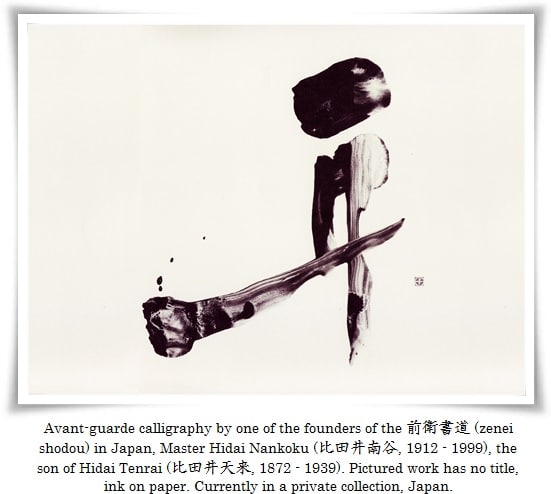The history of avant-garde calligraphy (前衛書道, zenei shodou) begins before World War II, although its raw idea was pursued only after the war ended. Precursors of this trend were a few master calligraphers of the early 20th century, who were cultivating further what grand master Hidai Tenrai (比田井天来) initiated in the 19th century. Today he is known as “ the father of modern calligraphy”.
The idea of avant-garde calligraphy is to deviate from the traditional approach to writing within rules defined by and gained through studying and copying ancient styles (five core traditional Calligraphy Styles: Seal script, Clerical script,Cursive script, Regular script and Semi-cursive script), and suggests a much more free and unrestrained way of expressing oneself through creating an “image of ink” (墨象, bokushou). In other words, zenei shodou ought to surpass any barriers of time, space and aesthetics, and unleash most subconscious and abstract feelings or spiritual states of the moment.
In this understanding, “image of ink” (which in a way is an alternative name for avant-garde shodo) is closely related to abstract painting of the 20th century, and in this capacity it may seem slightly ahead of its time (especially in the rigid world of traditional calligraphy). One needs to remember however, that this trend was developed by master calligraphers, and their knowledge of calligraphic art was superior.
It could be understood that at a certain level of studying, a given art-gained knowledge and subconscious experience are so high, that one enters a state of permanent enlightenment. The unity of body and soul of an artist takes on a real life form, and enters the world of mortals concealed within black lines of “images of ink” created in single brush strokes.
Not many people seem to know that Chinese or Japanese calligraphy has nothing to do with writing pretty characters, but instead it is all about expressing oneself through art. Zenei Shodo is a spiritual art of arranging space around black lines of characters or images, brought to even higher levels, where fuss over aesthetics, being comprehended in common fashion, is irrelevant, and hence, virtually nonexistent.
To summarize, Zenei Shodo is all about deviating from the traditional calligraphy and creating new aesthetics based on the appreciation of the beauty of Chinese characters by excluding the idea of characters and focusing on the art of designing space (or “the void” (空, kuu) from Japanese philosophy of five elements), far away from the “entangling” rules of calligraphy. The paradox is that to be able to become a master of avant-garde calligraphy one needs a solid basis and years spent in practicing classical sho.
There are many styles out there, and as many handwritings as there are calligraphers on Earth, but despite all of those differences they all have one thing in common. Whenever you look at calligraphy you are not only blessed with subliminal-like aura of black lines, elusive seas of white space, characters and their infinite forms or fascinating stories they convey.You have the privilege of seeing inside the soul of another human being without any filters or modifiers. Personally, it makes me appreciate the truth, that both writing and admiring calligraphy are splendid moments worth living for.

